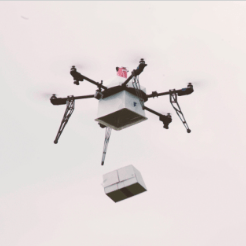
Working in collaboration with researchers from Johns Hopkins University, Flirtey loaded a supply drone with medical samples and delivered them from land to a medical screening facility located on a barge.
After the successful first delivery, researchers on the barge sent water purification tablets, insulin and a first aid kit back to shore on the drone. Flirtey’s proprietary delivery drone is a carbon fiber and aluminum 6-rotor vehicle.
The test successfully demonstrated the drone’s ability to participate safely in humanitarian and disaster relief applications, where relief medical ships may be located in choppy waters. The test took place in New Jersey’s Delaware Bay, flying through the Cape Could Canal to deliver its cargo on land at the Cape Could-Lewes Ferry Terminal.
The flight was FAA-permitted, as was Flirtey’s first two demonstrations of drone delivery in the U.S. The test comes shortly after the FAA’s release of Part 107 Small UAS Rule, which opens the skies to a broader variety of commercial applications but still restricts flight beyond visual line of sight (BVLOS) and under other conditions necessary for drone delivery.
Flirtey recently published a comment about the new regulations, saying that while the new rules represented a step in the right direction, the FAA should move forward quickly to support the drone industry or risk seeing it move overseas: “As a company that worked with the FAA to conduct the first FAA-approved drone delivery and the first fully autonomous drone delivery in an urban setting, we know that safety can be balanced with more progressive rules that allow drone companies like ours to transform humanitarian response, delivery systems and logistics networks,” said the Flirtey statement. “…Countries like New Zealand are currently leading the charge in creating risk-based regulations for commercial drone applications, and the FAA must move quickly to assure the U.S. does not fall behind in the rapidly advancing global growth of drones.”

Miriam McNabb is the Editor-in-Chief of DRONELIFE and CEO of JobForDrones, a professional drone services marketplace, and a fascinated observer of the emerging drone industry and the regulatory environment for drones. Miriam has penned over 3,000 articles focused on the commercial drone space and is an international speaker and recognized figure in the industry. Miriam has a degree from the University of Chicago and over 20 years of experience in high tech sales and marketing for new technologies.
For drone industry consulting or writing, Email Miriam.
TWITTER:@spaldingbarker
Subscribe to DroneLife here.
